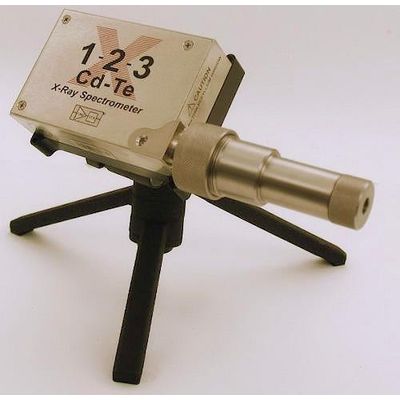

- Home
- Companies
- Amptek - AMETEK
- Products
- Amptek - Medical X-Ray Detector for ...

Amptek - Medical X-Ray Detector for Mammography and Radiology
This detector system was designed to simultaneously measure the X-Ray tube peak potential (kVp), and to characterize the mammographic X-Ray tube spectrum.
Equipment needed
- X-123CdTe Complete X-ray and gamma ray Spectrometer
- EXVC Collimator Kit
- XRS-FP Escape Peak Adjustment Software
Design Objective
This detector system was designed to simultaneously measure the X-Ray tube peak potential (kVp), and to characterize the mammographic X-Ray tube spectrum.
Significance of the Measurement
- Both the tube spectrum and the peak potential (kVp) are important parameters affecting the image quality in film-screen and digital mammography.
- Automatic selection of proper target/filter combination in modern mammography systems may be affected by improper kVp.
- In conventional devices, the user depends on central laboratory calibration and has no easy way to calibrate the instrument during use.
Complete System Includes:
- Detector – X-123CdTe
- Collimator Kit – EXVC
- Escape Peak Adjustment Software – XRS-FP
System Description X-123CdTe
Amptek’s specialty is X-ray and gamma-ray spectrometers, which are small, low power, high performance, and simple to operate. The X-123CdTe combines in a single package Amptek’s standard, high performance X-ray spectroscopy components: the XR-100CdTe detector and preamplifier, DP5 digital pulse processor and MCA, and PC5 power supply. The result is a complete integrated system which can fit in your hand. In many commercially available systems, the preamplifier alone has more size, mass, and power than this integrated system. It requires only 2 connections to run: +5 VDC power and a standard RS-232, USB, or Ethernet connection. With the X-123CdTe, anyone can rapidly obtain high quality X-ray and gamma-ray spectra.
Collimator Kit
Amptek has developed the EXVC Collimator Kit to collimate the primary X-ray beam. The Collimator Housing can accommodate up to two Tungsten collimator disks that are placed inside a bayonet holder in front of the detector. By selecting the appropriate Tungsten collimator disks, the user can reduce the incoming X-ray flux and allow the detector and electronics to process the X-ray spectrum. Seven different Tungsten collimator disks are provided with different size holes (ranging from 25 µm to 2,000 µm hole) in order to allow for a wide range of applications. The Collimator Housing is made out of stainless steel.
The kit includes
- Stainless steel collimator housing
- Tripod and mounting plate
- Laser pointer
- Brass Spacer
- 5 Tungsten (W) Collimator disks:
- 1 mm thick with 25 µm hole
- 1 mm thick with 50 µm hole
- 2 mm thick with 400 µm hole
- 2 mm thick with 1000 µm hole
- 2 mm thick with 2000 µm hole
All Tungsten disks are made of alloy HD17 (90% W, 6% Ni, 4% Cu).
All Tungsten disks and spacers have a diameter of 0.625 inches.
Optional: EXVC-W-SPACER
This Tungsten (W) Spacer /Collimator is 36 mm thick with a 300 µm hole. It is designed to stop and collimate x-rays greater than 100 keV produced from high energy tubes.
Escape Peak Adjustment with XRS-FP Software
The XRS-FP software can be used to adjust the output spectrum for the escape peaks of the CdTe detector. This can be a significant effect for higher energy x-ray tubes that operate above the absorption edges of Cd and Te.
For more information please see the application note ANCDTE1: CdTe Measurement of X-Ray Tube Spectra: Escape Events.
Plot showing a tungsten (W) x-ray tube output spectrum taken with a CdTe detector after processing to remove escape events. The gray trace shows the original spectrum. The green trace illustrates the escape events in the original spectrum. These are subtracted from this original spectrum, then the correct energies are computed (by adding in the energy which escaped). The blue trace shows the corrected escape events, which are then summed with the gray trace. The dark black trace shows the final result of the processing with the events in their correct channels.
- Direct Measurement Spectra
- End Point Energy (kVp)
- See what the patient gets:
- No Compton Spectra
- Escape Peak Adjustment via XRS-FP Software
- Self-Calibrating System
- Look straight at the X-Ray tube and record simultaneously both the spectrum and the peak potential (kVp)
- The technology that went to Mars on the Pathfinder Mission is now available to Radiology!
- A must detector for every Radiology Department
- For Quality Assurance in Radiographic and Fluoroscopic Systems
